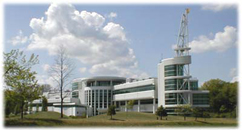|
Advances in Atmospheric Science have occurred as a result of our ability to observe and measure, with increasing accuracy,
the properties of the atmosphere. This is true in dynamic meteorology, in physical meteorology, and especially in atmospheric chemistry.
Many of the most important chemical species are only present at the part-per-billion (ppb) or part-per-trillion (ppt) level, so it is
crucial that we make accurate and repeatable measurements down to these levels.
Predominantly, the atmospheric chemistry group deals with the measurements of atmospheric trace gases; especially those involved in tropospheric
ozone production and airborne particulate matter. Another major area of research is aimed at developing instrumentation for the measurement of
chemical composition of the atmosphere, primarily the more reactive species.
In particular, ASRC scientists have worked on Laser Absorption Spectrometers for methane (CH4) and for hydrogen peroxide
(H2O2). These instruments use mid-infrared gas lasers, multipass absorption cells, and frequency
modulation detection techniques. After a period of laboratory development, the new instruments will be used for measurements in the field.
For instance, in 1995 they outfitted a New York State Department of Environmental Conservation owned recreational van (RV) with gas analyzers
for O3, CO, NO-NOX, NO-NOY, SO2, and hydrocarbons, and sited this mobile air monitoring station near Corning in southwestern New York. The station
also makes routine meteorological measurements of wind speed, wind direction, temperature, humidity, precipitation, solar, and UV radiation.
The field station at Pinnacle State Park was part of a network of 9 similarly equipped sites throughout the Northeastern US involved in a
coordinated program to study tropospheric ozone pollution. Using extensive data from many sites will allow us to better determine the sources
of ozone pollution. In 1999 the RV was replaced with a prefabricated air monitoring shalter, and we began to measure
airborne particulate matter (aerosols or PM2.5) in addition to the gaseous pollutants and precursors.
|

